Brandon Nimmo
In 1966, the Mets made what was perhaps their worst decision in franchise history. With the first overall pick in the draft, the Mets selected Steve Chilcott. It was the worst decision in franchise history not only because Chilcott never played in the majors. It was the worst decision in franchise history for the reasons why the Mets didn’t make the obvious pick.
No, the Mets passed on a player named Reginald Martinez Jackson, or as you better know him, Reggie Jackson. This wasn’t a case of a player being overlooked for another player. No, Reggie was widely seen as the best player in that draft as was evidenced by the then Kansas City Athletics selecting him with the second overall pick in the draft. The Mets didn’t pass on Reggie because they felt stronger about Chilcott than other organizations (although they might have). They didn’t pass on Reggie because they believed he wasn’t suited for New York (turns out he was). They didn’t even pass on him because they felt there was an organizational need for a catcher (they didn’t with Jerry Grote aboard). No, the Mets passed on Reggie for the dumbest reason of all – racism. It turns out the Mets didn’t like the fact that he was dating a Hispanic woman.
When Reggie Jackson got his opportunity to exact revenge upon the Mets, he did. Reggie was the MVP of the 1973 World Series. While the Mets were floundering in the late 70’s, barely getting over a million fans to Shea Stadium, actually lower in other years, Reggie was leading the Yankees to the 1977 and 1978 World Series. In 1993, he was inducted into the Baseball Hall of Fame as a Yankee.
Meanwhile, Chilcott flamed out at 23, in part, because he suffered a shoulder injury. Chilcott became an unfortunate footnote in MLB history as the first ever first overall pick not to make the majors. It’s worth nothing that the Mets did eventually get the first overall pick right when they picked Darryl Strawberry in 1980. It’s also worth nothing that no first overall pick made the Hall of Fame until this summer when the 1987 first overall pick, Ken Griffey, Jr. will officially be enshrined in Cooperstown.
Overall, the MLB draft is full of hits and misses. It’s natural for players to be compared with the players who were drafted above and below them. Drafting in major league baseball is an inexact process. We were reminded of that this past weekend with Jose Fernandez shutting down the Mets, while the player drafted immediately before him, Brandon Nimmo, is still developing in AAA. However, we can live with decisions like Nimmo over Fernandez as there were sound reasons to draft Nimmo over Fernandez. If Nimmo continues his current development, he will become an effective major league player. That’s a lot more than anyone can say about Chilcott.
It’s important to keep the Reggie Jackson/Steve Chilcott situtation in mind each and every draft. There are busts, and there are players who exceed expectations. The only thing you can ask of your team is to have the right process in place when making draft picks. The Mets didn’t have the right approach in 1966. Presumably now, even in the absence of Paul De Podesta, the Mets have the right process in place. As such, we know the Mets are going to make a decision based upon the proper criteria. Accordingly, we know that the Mets are about to make a much better draft pick than the one they made in 1966.
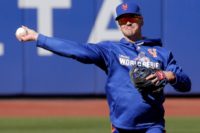
Due to the stress Jacob deGrom‘s injury and Steven Matz‘s short start out on the bullpen, the Mets were forced to call-up Rafael Montero to add a fresh arm to the bullpen. Rather than out deGrom on the DL or demote another pitcher, the Mets sent down Eric Campbell. Even with deGrom looking more and more like he will miss his next start, the Mets still won’t put him on the DL. Essentially, the Mets robbed Peter to pay Paul.
With a weekend Interleague series in Cleveland, the Mets can get away with a short bench. While it does limit their ability to pinch hit and make defensive substitutions, they should be able to navigate the situation because they won’t have to pinch hit for a pitcher. However, come Monday, they’re back to playing National League ball, and they’re going to need a full bench.
Whatever your feelings on Campbell is, he’s not going to be eligible to be recalled. Unless deGrom (or someone else) goes on the DL, Campbell will have to spend 10 days in the minors. Looking over the Mets 40 man roster, there would be three eligible candidates: Dilson Herrera, Matt Reynolds, and Brandon Nimmo. Now with one extra spot left on the 40 man roster due to Zack Wheeler being on the 60 day DL, the Mets could recall another player like a Ty Kelly.
In reality, the decision is between Reynolds and Kelly. Nimmo isn’t quite ready, and even if he was, the last thing the Mets need is another outfielder. Herrera still hasn’t started playing games in the field yet due to a sore shoulder, and even if he has been, the Mets see him as the second baseman of the future. They’re not wasting service and development time for him to be on the bench.
Kelly is 27 years old, and he has yet to play in the majors. He plays second, third, and the corner outfield positions. He’s a very disciplined hitter, who is extremely selective at the plate. For reasons that aren’t completely clear, he’s spent five seasons in Triple-A, and he’s never played a major league game. Overall, the truth really is Triple-A is his ceiling. At best, he’s a AAAA player.
Even if that assessment was wrong, it’s still not time to call-up Kelly. First, the Mets would have to add him to the 40 man roster and would not be able to denote him unless he clears waivers. Additionally, his skill set doesn’t match what this team needs. There’s no room for him in the outfield. Terry Collins is going to play Neil Walker almost everyday. So in essence, while Kelly has some versatility, the positions he plays do not match the Mets’ needs.
Accordingly, Reynolds is the player the Mets need to recall. During Spring Training and this early minor league season, Reynolds has played every infield position but first. His addition to the major league roster would create more flexibility across the infield. It would permit Collins to sit both Asdrubal Cabrera and Lucas Duda in the same game. Additionally, it would permit Collins to double switch with any player with the full knowledge that there’s another player on the bench who is fully capable of playing any position should another double switch be needed or there was an injury.
Offensively, Reynolds is a right hand batter who profiles better at the next level than Kelly. He’s not as patient as Kelly, but then again no one is. Reynolds profiles as a gap to gap line drive hitter. He does have more pop in his bat than Kelly. More importantly, at the very least, Reynolds projects as a bench player.
If Reynolds is going to wear a Mets uniform past smiling and waiving before Game One of the NLCS, he’s going to be a super-utility man in the mold of Flores or Joe McEwing. Reynolds has worked hard at it during the offseason and Spring. He knows this is his future, and he’s fully embraced it.
Better yet, he’s scorching hot right now. He’s hitting .353/.476/.529 with a homerun in five games. In those fives games, he’s played second, third, and short. At this point the only plausible reason for not calling up Reynolds is the Mets want to have a short bench.
Reynolds has earned his shot, and he’s playing well. It’s time for the Mets to call-up Reynolds.
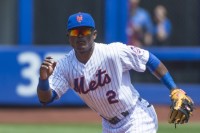
After the Mets make a decision at catcher, the team appears like they will have between $82 – $96 million to build a roster and re-sign their pitching.
Looking at the roster, the Mets will need to obtain starters at the following positions: 1B, 2B, SS, and RF. David Wright is scheduled to make $15 million, so whether or not you believe he will be able to stay at the position, he will remain with the team in some capacity. Michael Conforto should still be with the team as the leftfielder. Finally, unless the Mets can move him, Juan Lagares and his $9 million salary will be the team’s centerfielder. The Mets organization is fairly well stocked with position players right now, and they might be able to fill out the roster with cheap, cost-controlled talent.
First Base
Somewhat controversely, Keith Law named Dominic Smith the 29th best prospect in all of baseball. He’s the first baseman of the future.
Accordingly to the scouting reports, Smith is a good defensive first baseman that should be able to hit. The debate really is whether he will hit for power. Whether or not he hits for power, people see him as being able to field the position and be a good major league hitter.
With Lucas Duda being a free agent in 2018, the Mets will need Smith to be ready. If he’s not ready, the Mets will need a stopgap. In either event, by the time the Mets pitchers start to become free agents, Smith should be the first baseman earning around $500,000.
Second Base
We have to assume that one of these years Dilson Herrera is going to transition from second baseman of the future to the Mets second baseman. With Neil Walker only having one year until free agency, it appears that time will be 2017.
Right now, Herrera has less than one year’s service time. For all the supposed newfound depth, it’ll probably be Matt Reynolds getting called up to the Mets. That will preserve his service time. It means that in 2019, Herrera should be the second baseman, and he will have accrued two full years service time. Unless he gets enough playing time, it appears like he will avoid Super Two status meaning he will be in the same $500 – $600 thousand range as Smith.
Shortstop
As far as organizational depth, the Mets seemingly have an embarassment of riches with two high end shortstop prospects with Gavin Cecchini and Amed Rosario. They also have the aforementioned Reynolds.
Given Asdrubal Cabrera‘s contract, Cecchini and Rosario are going to have time to develop on the minors. At a minimum, Cabrera is signed to be the Mets shortstop through the 2017 season. If he produces well, or the prospects need another year, Cabrera has an option that could keep him with the Mets through the 2018 season.
As such, neither Cecchini or Rosario will be arbitration eligible at the time the Mets pitchers start to reach free agency. Accordingly, the Mets will only have to spend around $500 thousand when the pitchers begin to become free agents.
Left Field
It seems Michael Conforto is the leftfielder of the past (2015), present, and future. He very well should be too. Even if Conforto doesn’t improve upon his 162 game averages he achieved as a 22 year old, who never played above AA, you’re getting a good defensive outfielder who will hit .270/.335/.506 with 26 homers and 75 RBI.
Fortunately, Conforto will not have accrued enough service time to achieve Super Two status. Unfortunately, Conforto will most likely become arbitration eligible the same time that the Mets pitchers are reaching free agency.
Looking over the past few years, there isn’t really a good comparable to Conforto. It seems that when teams have good young corner outfielders, they lock them up. With that in mind, although an admittedly imperfect comparison, J.D. Martinez is instructive.
In 2014, Martinez was 26 years old, and he hit .325/.358/.553 with 23 homers and 76 RBI in 123 games. He became arbitration eligible after this season, and he agreed to $3 million. In 2015, he had another good year hitting .282/.344/.535 with 38 homeruns and 102 RBI. He and the Tigers avoided an arbitration hearing. Martinez’s contract extension bought out the remainder of his arbitration years he’s due to make $6.75 million in 2016 and $11.75 million in 2017.
While we may or may not agree on whether Martinez is a good comparable, it would be fair to say Conforto is at least capable of hitting .272/.344/.535 by his age 25 season, if not sooner. If that’s the case, it would be fair to suggest Conforto could earn anywhere from $3 – $6 million in his first year of eligibility.
Right Field
Curtis Granderson‘s contract will expire after the 2017 season. Since he will be 37 heading into the 2018 season, it’s hard to imagine he will be re-signed to be the everyday right fielder.
Now, Wuilmer Becerra projects to be an everyday player. Scouts believe he has the bat to play the corner outfield spot. The issue as far as the Mets are concerned is how quickly the 21 year old minor leaguer will need before fulfilling that promise. Last year, Becerra played his first year in full season A ball. That’s a long trek to the majors by 2019.
So unless Brandon Nimmo can handle the corner outfield offensively, which unfortunately seems unlikely, the Mets will have to look outside the organization to fill that void.
If Becerra is still a well regarded prospect, the Mets are likely to bring in a player on a one to two year deal. In retrospect, depending on how he finishes out his contract, Granderson could be coaxed back on a one-year deal ata much lower contract price.
As a placeholder, let’s presume the cost of a right fielder would cost about $15 million. That’s what Granderson is slated to earn the last year of his contract.
Cost of the Projected 2019 Starting Lineup
If everything breaks right for the Mets, they will have a group of young, cost-controlled position players at the time their starting pitchers hit the free agent market. If this pans out, the Mets everyday position players would cost about $46.5 million.
That’s roughly what the Mets are paying their current starting infield. In total, the 2016 Mets starting lineup is due to be paid roughly $90 million. Essentially, the Mets will be spending half the amount of money on their starting lineup in 2019 than they will this season.
Overall, this leaves the Mets between $35.5 – $49.5 million to build a bench, a bullpen, and to pay their starting rotation if the payroll remains stagnant at the $140 million range.
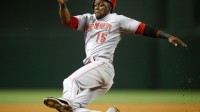
Yesterday, the Mets signed Roger Bernadina to a minor league deal. Anytime the Mets sign a player on a minor league deal, I think it’s a great low risk high reward move.With that said, I’m curious why the Mets signed Bernadina.
Bernadina is a 31 year old outfielder that was originally signed by the Montreal Expos. He played three full seasons with the successor Nationals before being released. Bernadina bounced around a bit since, and he spent all of 2015 in the minor leagues. He’s a career .236/.307/.354 hitter. He’s played all three outfield positions in his career reasonably well. Considering the Brandon Nimmo injury and the Darrell Ceciliani trade, this was a good depth move. Or was it?
His current deal with the Mets he has a June 15th opt out clause. That’s the same day the Mets can trade Alejandro De Aza without any restrictions. This begs the question whether Bernadina was signed as minor league depth, or whether he was signed so the Mets could trade De Aza? Is Berndina slated to be the fifth outfielder or is he really just depth to protect against injury?
Time will tell. In either scenario, this was a solid organizational depth move by the Mets.

Something occurred to me last night. The Mets have a real problem this offseason. It’s one that they partially created. In a nutshell, they arrived too soon.
At the beginning of 2015, no one saw the Mets winning the NL Pennant. They were coming off a 79-83 season. The already dominant Nationals added Max Scherzer. Bryce Harper wasn’t the only one who thought the Nationals were bound to win a ring. Even with Jacob deGrom winning the Rookie of the Year and the return of Matt Harvey most thought the best case scenario was the Mets competing for one of the Wild Cards.
What happened? The National faltered so badly they had to fire their manager. deGrom was even better than he was in his rookie year. Harvey showed no rust and has no setbacks in his first season back from Tommy John surgery. The Mets offense and his play in AA forced the Mets to call up Michael Conforto, who played well. Noah Syndergaard had an incredible rookie year. Jeurys Familia became a great closer.
Add that to Curtis Granderson having a great year and an amazing two months from Yoenis Cespedes, the Mets win 90 games and win the NL East. When the young pitching delivers in the postseason and Daniel Murphy becomes unhittable, you win a pennant. Man was that an unlikely pennant. Going into the year, you would’ve thought everything wouldn’t had to break right for the Mets to get to this point. It was quite the opposite.
Zack Wheeler‘s season was over before it began with him needing Tommy John surgery. David Wright missed most of the season with spinal stenosis. Murphy was in and out of the lineup in the first half with injuries. Michael Cuddyer wasn’t as good as they hoped, got hurt, and became an expensive bench player. Wilmer Flores struggled at shortstop creating a strange platoon with Ruben Tejada. Dilson Herrera couldn’t fill the gaps because he still wasn’t ready. Travis d’Arnaud had two long DL trips, and his replacements couldn’t hit. Juan Lagares took big steps back offensively and defensively. Lucas Duda had a streaky year with prolonged slumps. Oh, and their closer, Jenrry Mejia, had not one but two PED suspensions.
Really, this wasn’t some magical season. It was frustrating for most of the year. It was magical from August on. If not fit the Nationals ineptitude, the Mets should’ve been dead and buried. The Mets should’ve been looking to build off of a strong 2015 season. The Mets still have prospects a year or two away. The year was really supposed to be 2017. That was the year the Mets pitching would’ve been firmly established with the Mets having quality players at every position across the diamond.
No, they’re way ahead of schedule. They’re ready to let Murphy walk after he’s been a solid player for many years, let alone that postseason. There’s no room for Cespedes. The Mets are again talking about not being able to expand payroll. It’s creating an air of frustration amongst the fan base. It’s strange considering what happened in 2015.
What’s also strange is a poor NL East is seemingly getting worse. The NL East may very well be there for the taking WITHOUT the Mets signing even one player. In actuality, not signing anyone could arguably be a prudent move for the future of the team.
Do you really want to block 2B with a large contract when Herrera is a potential All Star. Do you grossly overpay for a bad shortstop when the Mets have not one but two big prospects at that position who are not far away? Why are you getting a terrible centerfielder when Brandon Nimmo is so close.
Do you block the path for some potential All Stars for aging players who MAY help you one year and be an albatross when the prospects are ready? How do you not build upon a team that went to the World Series last year? Can you reasonably ask a fan base to wait another year after all the losing? How do you explain last year might’ve been a fluke?
That’s the Mets real problem. They’re trying to juggle the present and the future. The front office is going to have to earn their money this offseason.
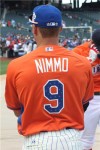
The first ever draft pick by the Samdy Alderson regime with the Mets was Brandon Nimmo. Today, he should be added to the 40 man roster, and he looks like he will begin the year in AAA.
When the Mets drafted him, they were just drafting on potential. Sure, you could make that argument with any first round pick, but it really applied to Nimmo. He played in Wyoming, a state that produces very few major league players. He showed glimpses of being a give tool player, but in a state like Wyoming, who really knows?
The Mets knew he was a long term project. That’s fine. You draft the best talent. He’s definitely talented. He’s a Top 100 MLB prospect and the Mets number two overall prospect (behind Steven Matz). He’s shown he can handle centerfield everyday. He’s got good speed and a good arm. While he may not have 20 home run power, he’s got a good eye and he’s a contact hitter. In his minor league career, he’s hit .263/.383/.391. After his call-up to AAA last year, he hit .264/.393/418 in 32 games.
It’s possible he gets called up in 2016. It’s even more possible he gets called-up in 2017. Fact is, the sooner he’s ready the better. Right now, the Mets seem to want a platoon bat in CF for Juan Lagares. They deem this such a need they’re talking with players who can’t play the position. Personally, I’d let Kirk Nieuwenhuis be the platoon option until Nimmo is ready. It’s not like Kirk is any worse than the other options. I believe everyone in the Mets organization wants Nimmo to force them to make the decision.
That’s why the clock is ticking. Everyone is waiting for him to take over CF. We’re looking forward to seeing Nimmo and Michael Conforto continue to drive each other to become the best players they can be. If they bring out the best in one another just watch out when they’re reunited in the majors.
I’d like to see Nimmo get his chance. I’d hate to see him blocked by what will be an albatross of a contract. Right now, it’s up to him. Conforto forced his way to the majors. Nimmo has to be the same. He’s now on the 40 man roster, which means there’s one less hurdle.
Soon, it will be Nimmo’s time.
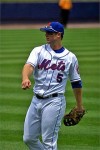
Mark Simon had a thought provoking article about moving David Wright off of third base.
His reasoning was sound. Wright’s defense has taken a noticeable step back. It played a part in costing the Mets two World Series games. While his throwing was never a string point, it’s gotten worse, and he throws more side armed now. Whether it’s his age or the stenosis, there may be a point in time when the Mets may have to move him off of third.
I just don’t think first base is the best option. Spinal stenosis is exacerbated by the typical twisting and turning actions you see on a baseball field. The stretching and turning at first would only exacerbate Wright’s stenosis. It may limit him further. I don’t think first is an option.
I’ve seen people suggest second. There’s no way I put him in the middle infield. Just remember what happened with Ruben Tejada. As a second baseman, Wright will have his back turned on many double play chances. I can’t put him in that position especially since he’s got limited mobility with his back.
There’s no good option in the infield. It’s why you might look to moving him into the outfield. Wright still has some speed and athleticism to cover the ground. He has shown the ability to track fly balls well, even if it has been at third base. His arm might be a liability in left, but it may be at third as well.
The Mets have a spot coming up in the outfield within the next few years. Curtis Granderson has two years left on his deal, and as good as he’s been, I can’t see the Mets re-signing him at 36 years old. From what we’ve seen so far from Michael Conforto, he should be able to handle RF. We don’t know what Brandon Nimmo or any other prospect will be.
We do know Wright will be around for another five years. Maybe he can stay at third. Whatever the case may be, the Mets should explore the possibilities.
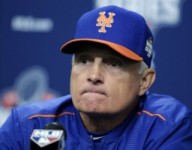
Today, it appears the Mets will meet with Terry Collins to discuss his future with the team. Collins has a 2016 option, but he wants a two year extension. Should he get it?
This isn’t the time to make an emotional decision. Terry Collins may have cost the Mets the World Series. It wasn’t just a bad week, he was a bad in game manager all year. If the Mets bring him back, he very well could cost the Mets a chance at the playoffs or a playoff series. It’s something that must be considered.
Another thing that must be considered is Collins’ handling of the team. He was handed a team with that should have imploded. There was great young pitching coupled with a AAA to AAAA lineup. He kept the Mets afloat allowing Sandy Alderson to make moves. The Mets had every reason to fall apart, but they didn’t. Collins had a huge part in that.
Also, keep in mind Collins comes from a player development background. He was the Mets minor league coordinator before becoming the Mets manager. He’s been a part of the development of the Mets young pitchers and hitters. He oversaw Daniel Murphy becoming a second baseman. He oversaw Lucas Duda become a power hitting first baseman.
He’s working with Wilmer Flores to become a SS. Brandon Nimmo and Dilson Herrera are on the horizon. We’ve seen teams win World Series with bad managers. However, we’ve also seen teams with poor managers waste talent. It’s why players like Jose Bautista become a star elsewhere. I don’t want that with the Mets players.
I also keep in mind that if you don’t want Collins, you have to figure out with whom you’re replacing him. The Nationals just passed on Bud Black, who is noted to be a good clubhouse, poor in game management type of manager. The Mets already have that, so why replace him. You could keep some continuity with Bob Geren, but he’s been noted to burn out young arms. Not the ideal choice.
This is also the time you’ll hear Mets fans clamoring for Wally Backman. This isn’t the time. This is a team that’s a championship contender. You don’t throw a wild card into that mix. Second, he’s been a part of the player development process. He’s sending players up to the big leagues major league ready. Why mess with that?
Ultimately, the Mets should give Collins his extension. He’s earned it. Even if you’re a detractor (which I understand), there’s not a better option out there . . . at least not a proven one. Collins should manage the 2016 Mets.